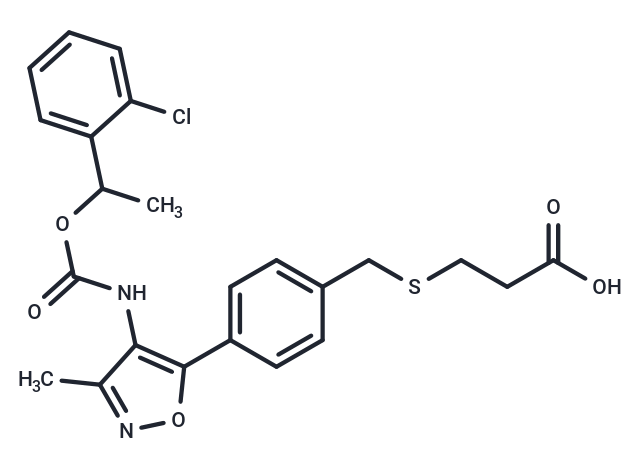Shopping Cart
Remove All Your shopping cart is currently empty
Your shopping cart is currently empty
Ki16425 (Debio 0719) is a competitive, potent, and reversible antagonist to LPA1, LPA2, and LPA3, with Ki values of 0.34 μM, 6.5 μM, and 0.93 μM, respectively.

| Pack Size | Price | USA Warehouse | Global Warehouse | Quantity |
|---|---|---|---|---|
| 2 mg | $35 | In Stock | In Stock | |
| 5 mg | $52 | In Stock | In Stock | |
| 10 mg | $90 | In Stock | In Stock | |
| 25 mg | $198 | In Stock | In Stock | |
| 50 mg | $387 | In Stock | In Stock | |
| 100 mg | $541 | In Stock | In Stock | |
| 1 mL x 10 mM (in DMSO) | $54 | In Stock | In Stock |
| Description | Ki16425 (Debio 0719) is a competitive, potent, and reversible antagonist to LPA1, LPA2, and LPA3, with Ki values of 0.34 μM, 6.5 μM, and 0.93 μM, respectively. |
| Targets&IC50 | LPA3:0.93 μM(Ki), LPA2:6.5 μM(Ki), LPA1:0.34 μM(Ki) |
| In vitro | Kil6425 preferentially inhibits LPA1- and LPA3-mediated responses but has only a moderate effect on LPA2. Ki16425 inhibits the LPA-induced Ca(2+) response in THP-1 cells, 3T3 fibroblasts, and A431 cells, but had only a marginal effect in PC-12 cells and HL-60 cells, which means that Ki16425 seems to be a useful tool for evaluating the involvement of specific LPA receptors in the short-term response to LPA. Ki16425 inhibits long-term DNA synthesis and cell migration as induced by LPA in Swiss 3T3 fibroblasts. [1] Ki16425 reduces the LPA-induced activation of p42/p44 mitogen activated protein kinase (MAPK), while acting as a weak stimulator of p42/p44 MAPK on its own, properties typical of a protean agonist. Ki16425 also significantly reduces the NGF-induced stimulation of p42/p44 MAPK and inhibited NGF-stimulated neurite outgrowth in PC-12 cells. [2] Ki16425 markedly inhibits the expressions of COX-2 protein induced by synovial fluids. The enhancement of the IL-1 action by LPA on COX-2 expression is also inhibited by Ki16425. [3] |
| In vivo | Ki-16425 (30 mg/kg, i.p.) completely blocks LPA-induced neuropathic pain-like behaviors, when administered 30 min but not 90 min before lysophosphatidic acid injection, suggesting that Ki-16425 is a short-lived inhibitor. Ki-16425 also inhibits nerve injury-induced up-regulation of Caα2δ-1 in the dorsal root ganglion and reduction of SP immunoreactivity in the spinal dorsal horn. [4] |
| Kinase Assay | High-throughput screening: Screening is conducted at the ICCB-Longwood screening facility. 10 μL of recombinant USP14 protein are dispensed into each well of a 384-well low volume plate in duplicate, using a Wellmate plate dispenser. 33.3?nL of compound from the library are pin-transferred into the wells using a Seiko pin transfer robotic system, followed by pre-incubation for about 30?min. The last two columns of each plate are used for positive and negative controls for the assay. To initiate the enzyme reaction, 10?μL of VS-proteasome plus Ub-AMC mixture are added to each well, using a Wellmate dispenser. Samples are then incubated for another 45?min. Ub-AMC hydrolysis is measured at Ex355/Em460 using an Envision plate reader. The final concentrations of USP14, VS-proteasome and Ub-AMC are 15?nM, 1?nM and 0.8 μM, respectively. The final concentration of test compound is approximately 17?μM. Enzymes and substrates are prepared in Ub-AMC assay buffer (50?mM Tris-HCl (pH?7.5), 1?mM EDTA, 1?mM ATP, 5 mM MgCl2, 1?mM DTT, and 1 mg/Ml ovalbumin). |
| Synonyms | Debio 0719 |
| Molecular Weight | 474.96 |
| Formula | C23H23ClN2O5S |
| Cas No. | 355025-24-0 |
| Smiles | CC(OC(=O)Nc1c(C)noc1-c1ccc(CSCCC(O)=O)cc1)c1ccccc1Cl |
| Relative Density. | 1.353 g/cm3 |
| Color | White |
| Appearance | Solid |
| Storage | Powder: -20°C for 3 years | In solvent: -80°C for 1 year | Shipping with blue ice/Shipping at ambient temperature. | |||||||||||||||||||||||||||||||||||
| Solubility Information | DMSO: 94 mg/mL (197.91 mM), Sonication is recommended. H2O: < 1 mg/mL (insoluble or slightly soluble) Ethanol: 84 mg/mL (176.86 mM), Sonication is recommended. | |||||||||||||||||||||||||||||||||||
| In Vivo Formulation | 10% DMSO+40% PEG300+5% Tween 80+45% Saline: 3.3 mg/mL (6.95 mM), Sonication is recommended. Please add the solvents sequentially, clarifying the solution as much as possible before adding the next one. Dissolve by heating and/or sonication if necessary. Working solution is recommended to be prepared and used immediately. The formulation provided above is for reference purposes only. In vivo formulations may vary and should be modified based on specific experimental conditions. | |||||||||||||||||||||||||||||||||||
Solution Preparation Table | ||||||||||||||||||||||||||||||||||||
Ethanol/DMSO
| ||||||||||||||||||||||||||||||||||||
| Size | Quantity | Unit Price | Amount | Operation |
|---|

Copyright © 2015-2025 TargetMol Chemicals Inc. All Rights Reserved.